Abstract
1. Selective antagonism of 5-HT4 receptors may provide therapeutic benefit in certain disorders of the myocardium, alimentary and lower urinary tract. We now report on RS 39604, a novel and selective 5-HT4 receptor antagonist and compare its pharmacological properties with those of SB 204070. 2. In guinea-pig striatal membranes, both RS 39604 and SB 204070 inhibited specific binding of [3H]-GR 113808 in a concentration-dependent manner yielding pKi estimates of 9.1 and 10.9, respectively. RS 39604 displayed a low affinity (pKi < 6.5) for 5-HT1A, 5-HT2C, 5-HT3, alpha 1c, D1, D2, M1, M2, AT1, B1 and opioid mu receptors and moderate affinity for sigma 1, (pKi = 6.8) and sigma 2 (pKi = 7.8) sites. 3. In the rat isolated oesophagus, precontracted with carbachol, RS 39604 (30-300 nM) behaved as a competitive antagonist towards 5-HT-induced relaxation (pA2 = 9.3; Schild slope = 1.0). We and others have shown previously that SB 204070 behaves as an unsurmountable antagonist in this preparation (pA2 approximately 10.5). In the guinea-pig isolated ileal mucosa, RS 39604 (30 nM) antagonized 5-MeOT-induced increase in short-circuit current (pA2 = 9.1). 4. In anaesthetized vagotomized micropigs, RS 39604, administered by the i.v. or intraduodenal (i.duod.) route, produced dose-dependent inhibition of 5-HT-induced tachycardia (ID50 = 4.7 micrograms kg-1, i.v. and 254.5 micrograms kg-1, i.duod). At maximal doses of 30 micrograms kg-1, i.v. and 6 mg kg-1, i.duod., the inhibitory effects of RS 39604 lasted for more than 6 h.(ABSTRACT TRUNCATED AT 250 WORDS)
Full text
PDF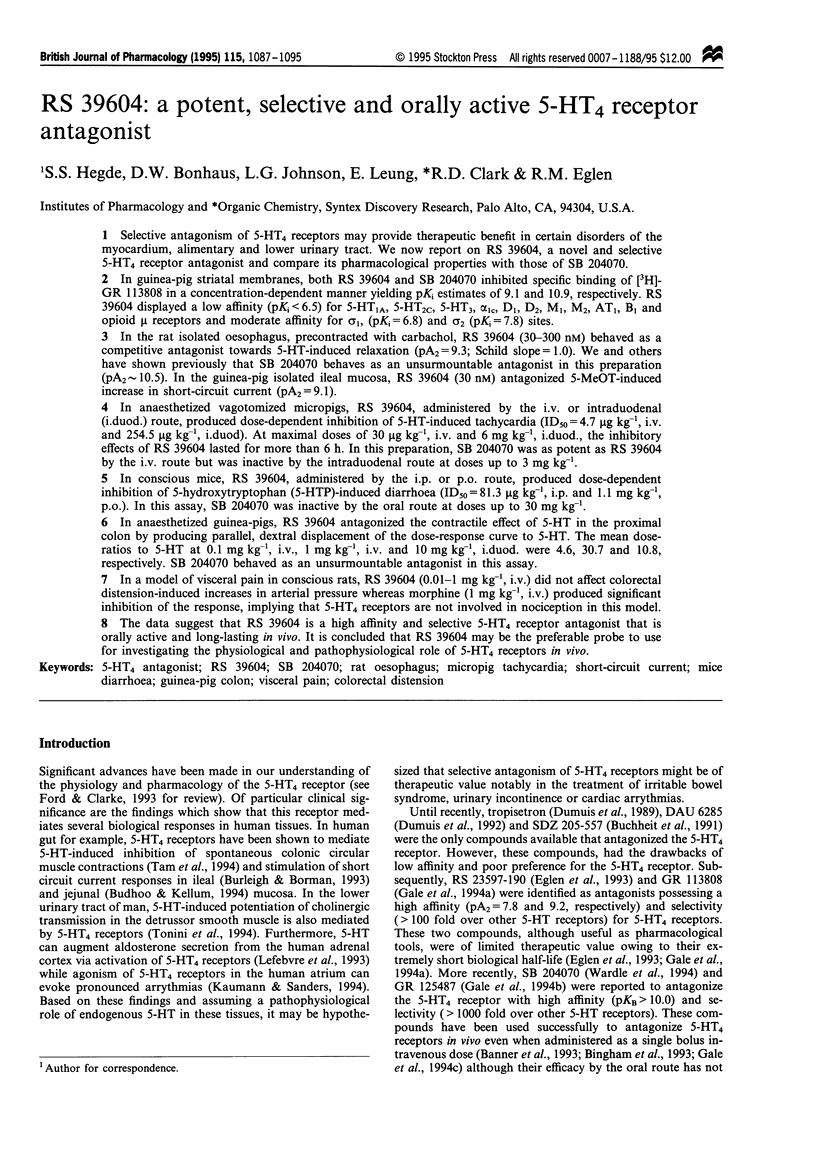
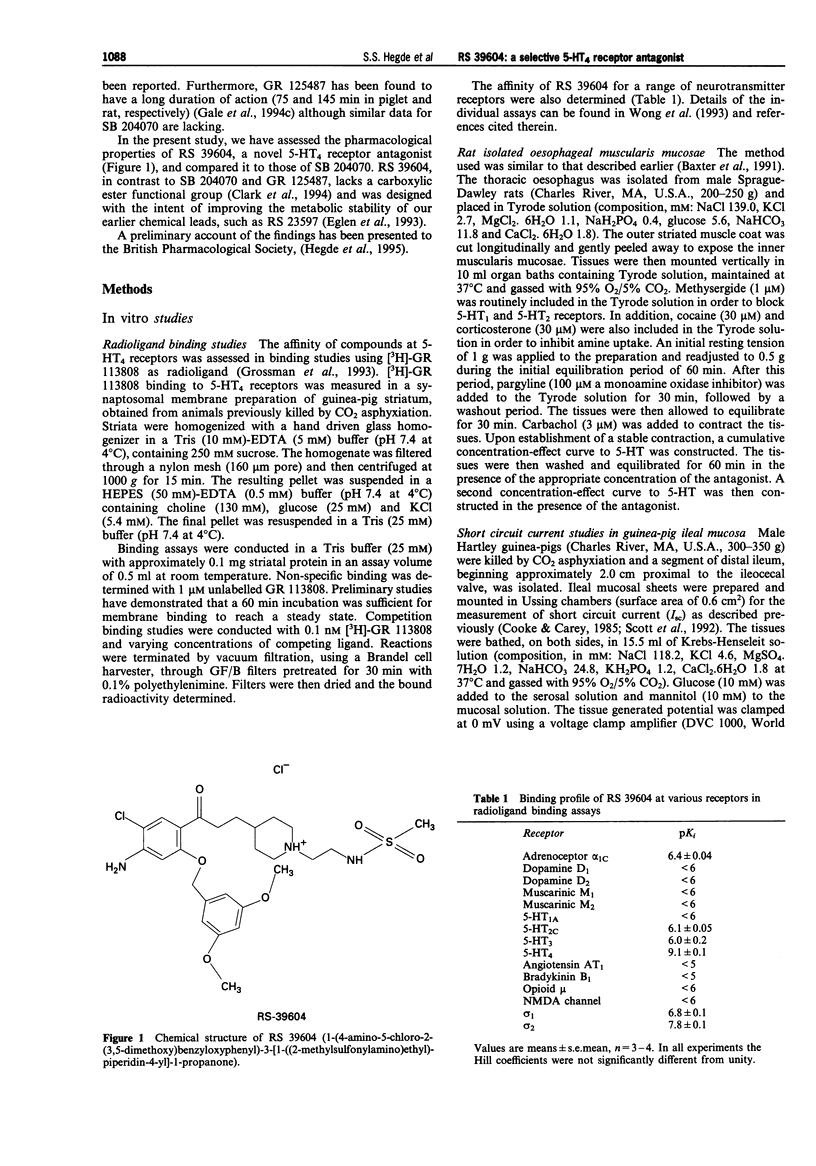
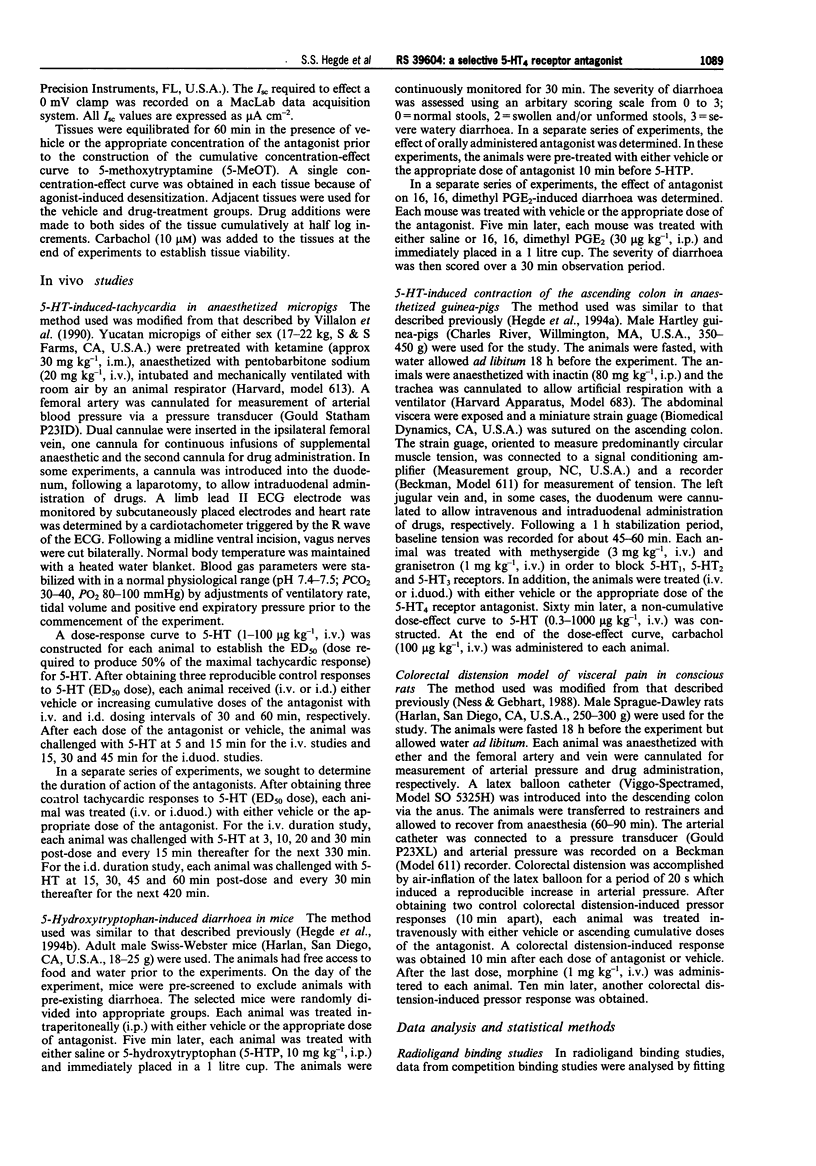
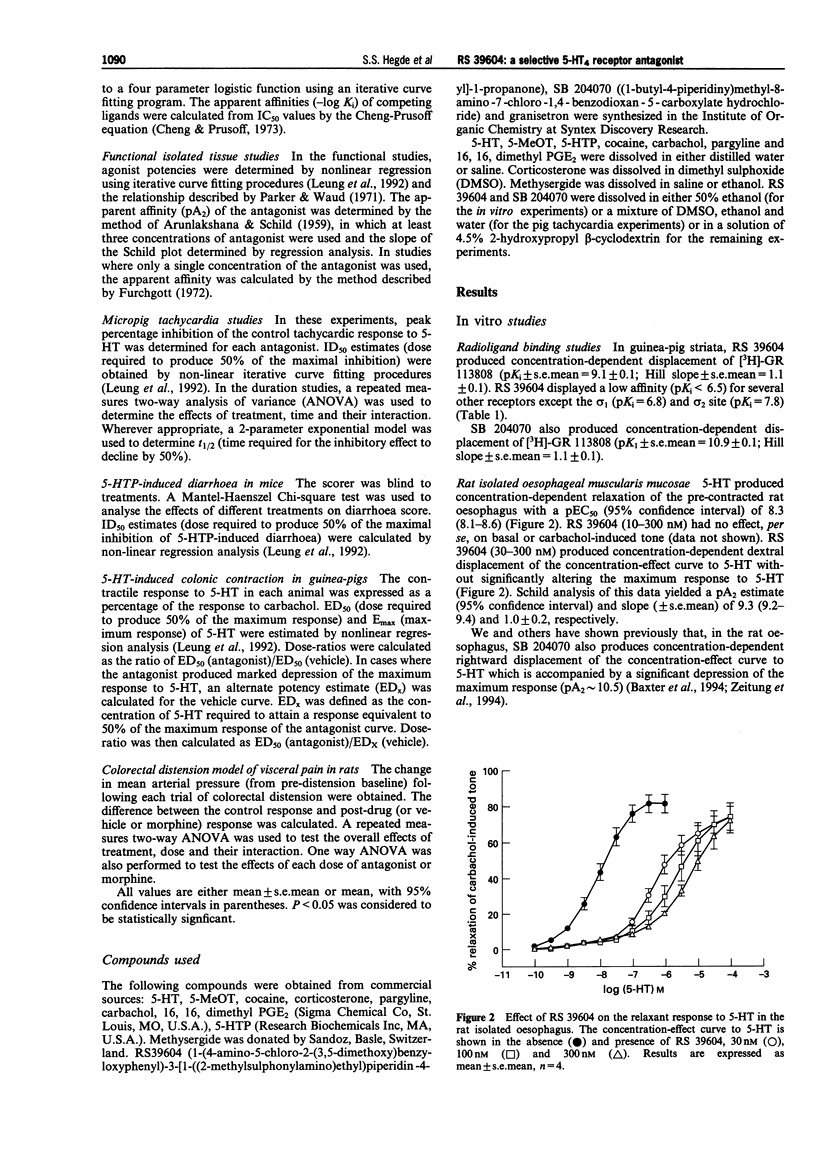
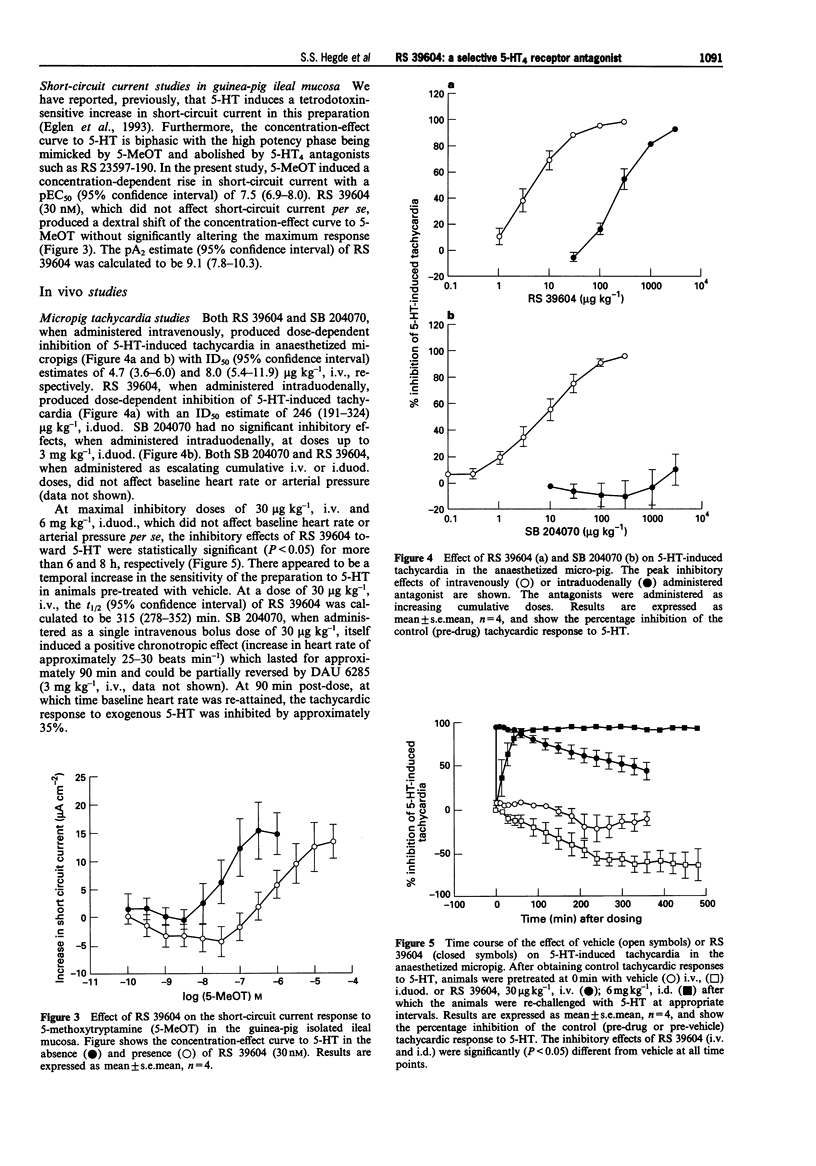
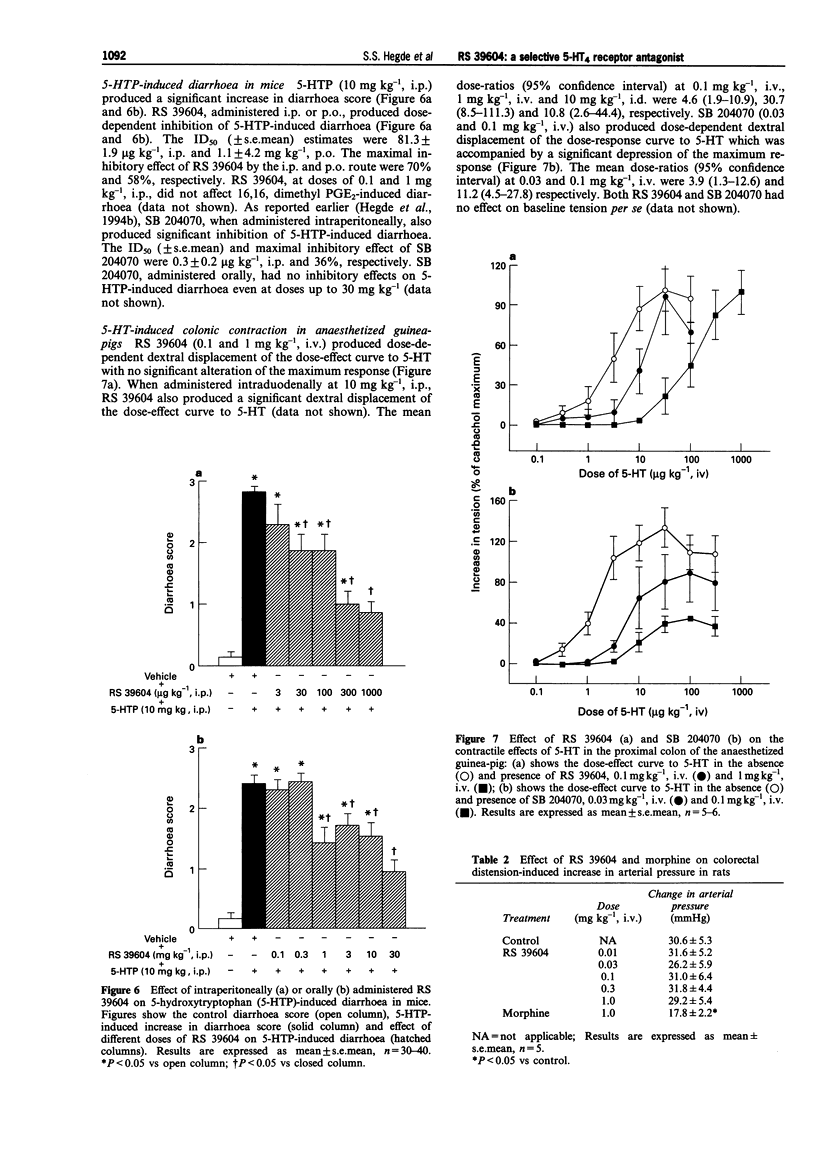
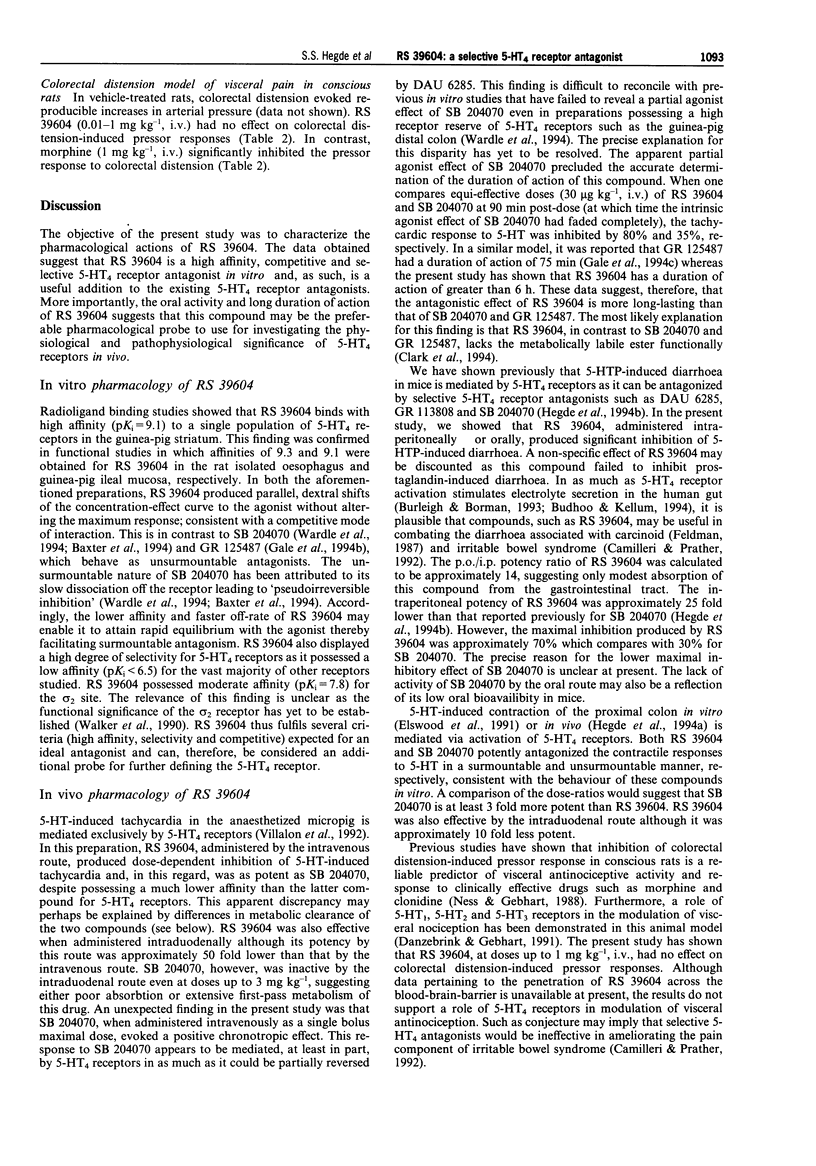
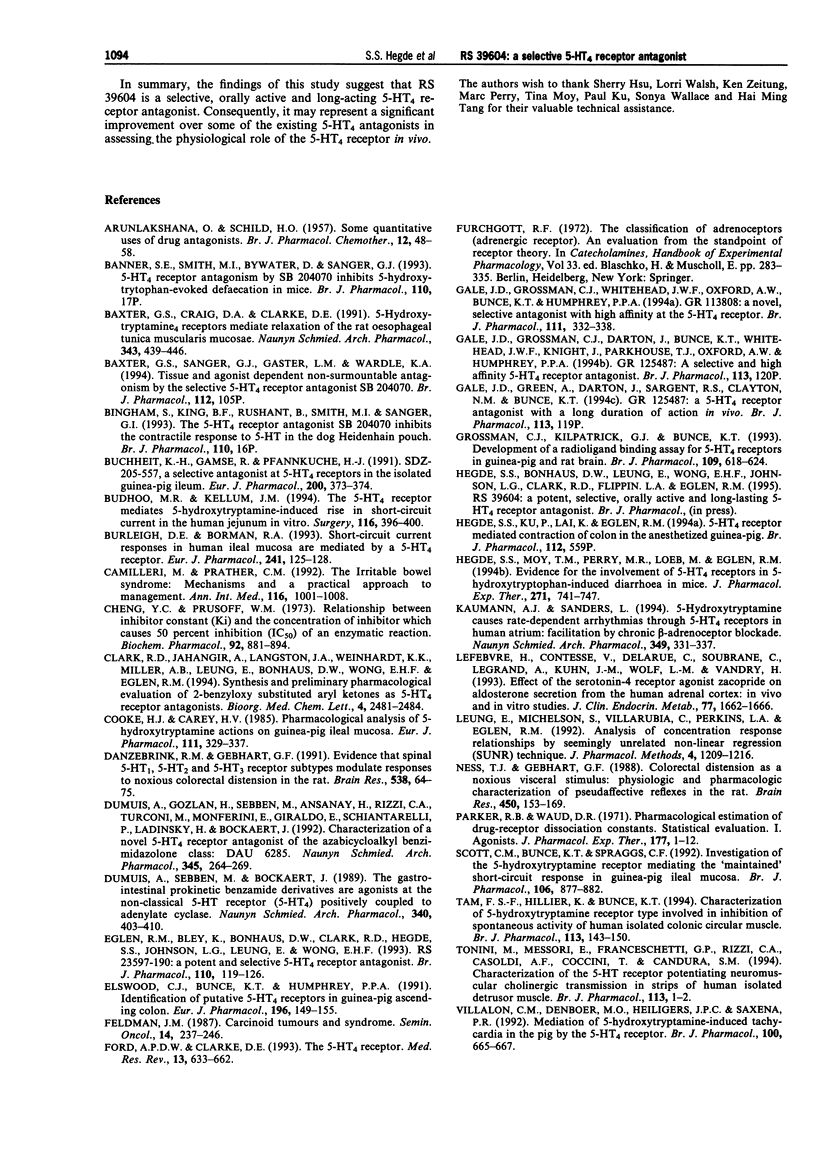
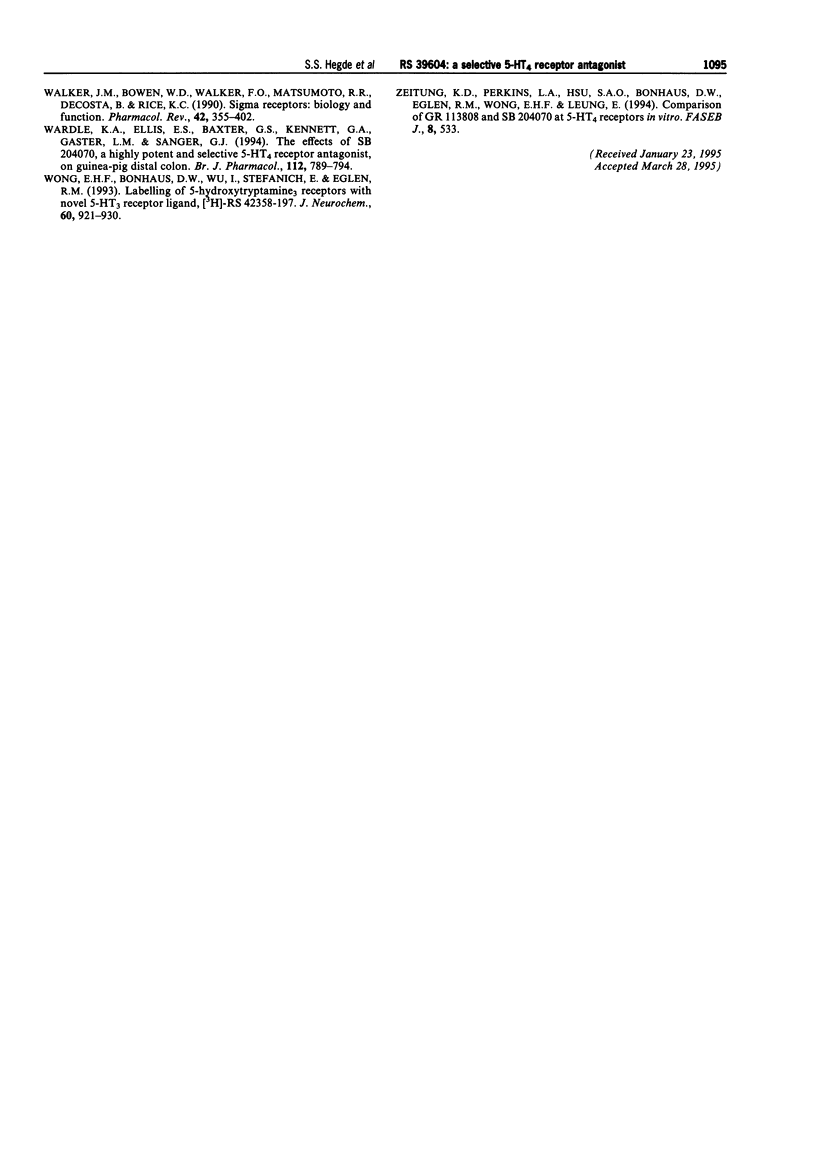
Selected References
These references are in PubMed. This may not be the complete list of references from this article.
- Baxter G. S., Craig D. A., Clarke D. E. 5-Hydroxytryptamine4 receptors mediate relaxation of the rat oesophageal tunica muscularis mucosae. Naunyn Schmiedebergs Arch Pharmacol. 1991 May;343(5):439–446. doi: 10.1007/BF00169544. [DOI] [PubMed] [Google Scholar]
- Buchheit K. H., Gamse R., Pfannkuche H. J. SDZ 205-557, a selective antagonist at 5-HT4 receptors in the isolated guinea pig ileum. Eur J Pharmacol. 1991 Aug 6;200(2-3):373–374. doi: 10.1016/0014-2999(91)90601-l. [DOI] [PubMed] [Google Scholar]
- Budhoo M. R., Kellum J. M. The 5-HT4 receptor mediates 5-hydroxytryptamine-induced rise in short circuit current in the human jejunum in vitro. Surgery. 1994 Aug;116(2):396–400. [PubMed] [Google Scholar]
- Burleigh D. E., Borman R. A. Short-circuit current responses to 5-hydroxytryptamine in human ileal mucosa are mediated by a 5-HT4 receptor. Eur J Pharmacol. 1993 Sep 7;241(1):125–128. doi: 10.1016/0014-2999(93)90943-c. [DOI] [PubMed] [Google Scholar]
- Camilleri M., Prather C. M. The irritable bowel syndrome: mechanisms and a practical approach to management. Ann Intern Med. 1992 Jun 15;116(12 Pt 1):1001–1008. doi: 10.7326/0003-4819-116-12-1001. [DOI] [PubMed] [Google Scholar]
- Cooke H. J., Carey H. V. Pharmacological analysis of 5-hydroxytryptamine actions on guinea-pig ileal mucosa. Eur J Pharmacol. 1985 May 20;111(3):329–337. doi: 10.1016/0014-2999(85)90639-9. [DOI] [PubMed] [Google Scholar]
- Danzebrink R. M., Gebhart G. F. Evidence that spinal 5-HT1, 5-HT2 and 5-HT3 receptor subtypes modulate responses to noxious colorectal distension in the rat. Brain Res. 1991 Jan 4;538(1):64–75. doi: 10.1016/0006-8993(91)90377-8. [DOI] [PubMed] [Google Scholar]
- Dumuis A., Gozlan H., Sebben M., Ansanay H., Rizzi C. A., Turconi M., Monferini E., Giraldo E., Schiantarelli P., Ladinsky H. Characterization of a novel 5-HT4 receptor antagonist of the azabicycloalkyl benzimidazolone class: DAU 6285. Naunyn Schmiedebergs Arch Pharmacol. 1992 Mar;345(3):264–269. doi: 10.1007/BF00168685. [DOI] [PubMed] [Google Scholar]
- Dumuis A., Sebben M., Bockaert J. The gastrointestinal prokinetic benzamide derivatives are agonists at the non-classical 5-HT receptor (5-HT4) positively coupled to adenylate cyclase in neurons. Naunyn Schmiedebergs Arch Pharmacol. 1989 Oct;340(4):403–410. doi: 10.1007/BF00167041. [DOI] [PubMed] [Google Scholar]
- Eglen R. M., Bley K., Bonhaus D. W., Clark R. D., Hegde S. S., Johnson L. G., Leung E., Wong E. H. RS 23597-190: a potent and selective 5-HT4 receptor antagonist. Br J Pharmacol. 1993 Sep;110(1):119–126. doi: 10.1111/j.1476-5381.1993.tb13780.x. [DOI] [PMC free article] [PubMed] [Google Scholar]
- Elswood C. J., Bunce K. T., Humphrey P. P. Identification of putative 5-HT4 receptors in guinea-pig ascending colon. Eur J Pharmacol. 1991 Apr 17;196(2):149–155. doi: 10.1016/0014-2999(91)90421-l. [DOI] [PubMed] [Google Scholar]
- Feldman J. M. Carcinoid tumors and syndrome. Semin Oncol. 1987 Sep;14(3):237–246. [PubMed] [Google Scholar]
- Ford A. P., Clarke D. E. The 5-HT4 receptor. Med Res Rev. 1993 Nov;13(6):633–662. doi: 10.1002/med.2610130603. [DOI] [PubMed] [Google Scholar]
- Gale J. D., Grossman C. J., Whitehead J. W., Oxford A. W., Bunce K. T., Humphrey P. P. GR113808: a novel, selective antagonist with high affinity at the 5-HT4 receptor. Br J Pharmacol. 1994 Jan;111(1):332–338. doi: 10.1111/j.1476-5381.1994.tb14064.x. [DOI] [PMC free article] [PubMed] [Google Scholar]
- Grossman C. J., Kilpatrick G. J., Bunce K. T. Development of a radioligand binding assay for 5-HT4 receptors in guinea-pig and rat brain. Br J Pharmacol. 1993 Jul;109(3):618–624. doi: 10.1111/j.1476-5381.1993.tb13617.x. [DOI] [PMC free article] [PubMed] [Google Scholar]
- Hedge S. S., Moy T. M., Perry M. R., Loeb M., Eglen R. M. Evidence for the involvement of 5-hydroxytryptamine 4 receptors in 5-hydroxytryptophan-induced diarrhea in mice. J Pharmacol Exp Ther. 1994 Nov;271(2):741–747. [PubMed] [Google Scholar]
- Kaumann A. J., Sanders L. 5-Hydroxytryptamine causes rate-dependent arrhythmias through 5-HT4 receptors in human atrium: facilitation by chronic beta-adrenoceptor blockade. Naunyn Schmiedebergs Arch Pharmacol. 1994 Apr;349(4):331–337. doi: 10.1007/BF00170877. [DOI] [PubMed] [Google Scholar]
- Lefebvre H., Contesse V., Delarue C., Soubrane C., Legrand A., Kuhn J. M., Wolf L. M., Vaudry H. Effect of the serotonin-4 receptor agonist zacopride on aldosterone secretion from the human adrenal cortex: in vivo and in vitro studies. J Clin Endocrinol Metab. 1993 Dec;77(6):1662–1666. doi: 10.1210/jcem.77.6.8263156. [DOI] [PubMed] [Google Scholar]
- Ness T. J., Gebhart G. F. Colorectal distension as a noxious visceral stimulus: physiologic and pharmacologic characterization of pseudaffective reflexes in the rat. Brain Res. 1988 May 31;450(1-2):153–169. doi: 10.1016/0006-8993(88)91555-7. [DOI] [PubMed] [Google Scholar]
- Parker R. B., Waud D. R. Pharmacological estimation of drug-receptor dissociation constants. Statistical evaluation. I. Agonists. J Pharmacol Exp Ther. 1971 Apr;177(1):1–12. [PubMed] [Google Scholar]
- Scott C. M., Bunce K. T., Spraggs C. F. Investigation of the 5-hydroxytryptamine receptor mediating the 'maintained' short-circuit current response in guinea-pig ileal mucosa. Br J Pharmacol. 1992 Aug;106(4):877–882. doi: 10.1111/j.1476-5381.1992.tb14428.x. [DOI] [PMC free article] [PubMed] [Google Scholar]
- Tam F. S., Hillier K., Bunce K. T. Characterization of the 5-hydroxytryptamine receptor type involved in inhibition of spontaneous activity of human isolated colonic circular muscle. Br J Pharmacol. 1994 Sep;113(1):143–150. doi: 10.1111/j.1476-5381.1994.tb16186.x. [DOI] [PMC free article] [PubMed] [Google Scholar]
- Tonini M., Messori E., Franceschetti G. P., Rizzi C. A., Castoldi A. F., Coccini T., Candura S. M. Characterization of the 5-HT receptor potentiating neuromuscular cholinergic transmission in strips of human isolated detrusor muscle. Br J Pharmacol. 1994 Sep;113(1):1–2. doi: 10.1111/j.1476-5381.1994.tb16163.x. [DOI] [PMC free article] [PubMed] [Google Scholar]
- Villalón C. M., den Boer M. O., Heiligers J. P., Saxena P. R. Mediation of 5-hydroxytryptamine-induced tachycardia in the pig by the putative 5-HT4 receptor. Br J Pharmacol. 1990 Aug;100(4):665–667. doi: 10.1111/j.1476-5381.1990.tb14073.x. [DOI] [PMC free article] [PubMed] [Google Scholar]
- Walker J. M., Bowen W. D., Walker F. O., Matsumoto R. R., De Costa B., Rice K. C. Sigma receptors: biology and function. Pharmacol Rev. 1990 Dec;42(4):355–402. [PubMed] [Google Scholar]
- Wardle K. A., Ellis E. S., Baxter G. S., Kennett G. A., Gaster L. M., Sanger G. J. The effects of SB 204070, a highly potent and selective 5-HT4 receptor antagonist, on guinea-pig distal colon. Br J Pharmacol. 1994 Jul;112(3):789–794. doi: 10.1111/j.1476-5381.1994.tb13148.x. [DOI] [PMC free article] [PubMed] [Google Scholar]
- Wong E. H., Bonhaus D. W., Wu I., Stefanich E., Eglen R. M. Labelling of 5-hydroxytryptamine3 receptors with a novel 5-HT3 receptor ligand, [3H]RS-42358-197. J Neurochem. 1993 Mar;60(3):921–930. doi: 10.1111/j.1471-4159.1993.tb03238.x. [DOI] [PubMed] [Google Scholar]


